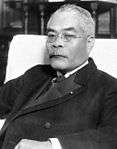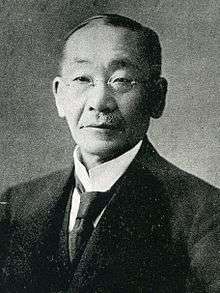Constitutional Democratic Party (Japan)
Rikken Minseitō (立憲民政党, Constitutional Democratic Party) was one of the main political parties in pre-war Empire of Japan. It was commonly known as the 'Minseitō'.
Rikken Minseitō 立憲民政党 | |
|---|---|
| Leader | Osachi Hamaguchi Wakatsuki Reijirō |
| Founded | June 1, 1927[1] |
| Dissolved | August 15, 1940 |
| Preceded by | Kenseikai Seiyūhontō |
| Merged into | Imperial Rule Assistance Association[2] |
| Headquarters | Tokyo |
| Ideology | Liberalism[3] Progressivism[4] Gikai Chūshin Seiji[5] Anti-Seiyūkai[1] |
| Political position | Centre[2] |
History
The Minseitō was founded on 1 June 1927, by a merger of the Kenseikai and the Seiyu Hontō political parties.[6] Its leadership included Osachi Hamaguchi, Wakatsuki Reijirō, Yamamoto Tatsuo, Takejirō Tokonami, Adachi Kenzō, Koizumi Matajirō and Saitō Takao. The party platform was politically and economically more liberal than its major rival, the Rikken Seiyūkai, calling for rule by the Diet of Japan rather than bureaucrats or genrō, elimination of disparities in wealth, international cooperation, and protection of personal liberties.[7] Its main base of support was the urban middle class, but its principal financial backing was the Mitsubishi zaibatsu.
The Minseitō fielded many candidates in the February 1928 General Election, (the first to be held after the General Election Law), winning 217 seats in the Lower House, as opposed to 218 seats for the Seiyūkai. This resulted in a hung parliament.
In the following 1930 General Election, the Minseitō took 273 seats, as opposed to 174 seats for the Seiyūkai, which gave it an absolute majority. Minseitō president Osachi Hamaguchi, Herbert Bix referred to him as Hamaguchi Yūkō,[8] became Prime Minister. Hamaguchi's first priority was to address the effects of the 1929 Stock Market Crash through retrenchment of government spending, tightening the money supply and encouraging exports while stabilizing foreign investments through returning to a fixed exchange rate.[9]
During its tenure, the Minseitō also advocated a conciliatory foreign policy, and ratified the London Naval Agreement of 1930. However, Hamaguchi fell victim to an assassination attempt on 14 November 1930 when he was shot in Tokyo Station by a member of an ultranationalist secret society. Wakatsuki Reijirō became acting Prime Minister, also from the Minseitō.
In 1931, Minseitō strongly opposed the Mukden Incident which was engineered by the Imperial Japanese Army.[10] The anti-war Foreign Minister Kijūrō Shidehara and Prime Minister Reijirō came under strong criticism for their intervention in military affairs, and were accused of "serious corruption", and his government collapsed in 1931.
In the following 1932 General Election, some right-wing members defected to the Rikken Seiyūkai, which won an absolute majority of 301 seats. Seiyūkai president Inukai Tsuyoshi became prime minister.
The Minseitō was able to recover a very slight majority of 205 seats versus 175 seats for the Seiyūkai in the 1936 General Election only by adopting a more pro-military stance. However, the narrow margin again resulted in a hung parliament. The Minseitō dropped back down to 179 seats in the 1937 General Election, while the Seiyūkai retained all of its 175 seats, which continued the paralysis in the Diet of Japan.
On 15 August 1940 the Minseitō voted to dissolve itself into the Imperial Rule Assistance Association as part of Fumimaro Konoe's efforts to create a one-party state, and thereafter ceased to exist.
Ideology
The Minseitō was established as an anti-Rikken Seiyūkai.[1] However there was no difference between the two parties in having a national goal for a constitutional monarchy.[11] The Minseitō has raised awareness of a two-party system through confrontation with the Seiyūkai [12] and aimed to establish it.[11] The Minseitō had no philosophy but they came to advocate 'liberty' and 'progress.'[13] That's because the first president, Hamaguchi, emphasized the values of 'liberty' and 'progress' as party basic philosophy in a statement at the establishment ceremony.[4] He defined Minseitō as a progressive party that respected individual liberty.[13] The Minseitō was aimed at incremental democratization and social democracy in cooperation with bureaucracy organization.[11] Because this party had many party members who were once bureaucrats.[11]
In addition, the Minseitō has advocated "Parliament-centric politics" (議会中心政治, Gikai Chūshin Seiji)[5] which shows the superiority of the lower house over the upper house, and incorporated it into the party platform.[14] This is due to the influence of former members of the Kenseikai legislators who have gained experience as politicians of party politics.[15] Seigō Nakano, the head of policymaking and public relations, declared that "The Minseitō will implement strong 'Parliament-centric politics' through good operation of the universal suffrage."[16]
Leaders
| No. | Name | Portrait | Term of office | |
|---|---|---|---|---|
| Took Office | Left Office | |||
| 1 | Osachi Hamaguchi |  |
1 June 1927 | 13 April 1931 |
| 2 | Wakatsuki Reijirō |  |
13 April 1931 | 1 November 1934 |
| 3 | Machida Chūji |  |
20 January 1935 | 15 August 1940 |
Election results
| Election year | # of seats | Change | Government |
|---|---|---|---|
| 1928 | 216 / 446 |
Opposition | |
| 1930 | 273 / 446 |
Government | |
| 1932 | 146 / 446 |
Opposition | |
| 1936 | 205 / 466 |
Government | |
| 1937 | 179 / 466 |
Opposition |
Notes
- Inoue 2012, p. 33.
- The Editors of Encyclopaedia Britannica. "Minseitō political party, Japan". Encyclopædia Britannica Online. Encyclopædia Britannica, Inc. Retrieved March 23, 2020.
- Inoue 2012, p. 48.
- Inoue 2012, pp. 39-40.
- Inoue 2012, pp. 36-37.
- National Diet Library
- Garon. The State and Labor in Modern Japan Page 137
- Herbert P. Bix, Hirohito and the Making of Modern Japan (New York, NY: HarperCollins, 2000), 208
- Gordon. A Modern History of Japan: From Tokugawa Times to the Present
- Young, Japan's Total Empire page 121
- Inoue 2012, p. ii.
- Inoue 2012, p. 45.
- Inoue 2012, p. 40.
- Inoue 2012, pp. 41-42.
- Inoue 2012, p. 36.
- Inoue 2012, p. 37.
References
- Garon, Sheldon (2001). The State and Labor in Modern Japan. Palgrave Macmillan. ISBN 0-312-23915-7.
- Gordon, Andrew (2008). A Modern History of Japan: From Tokugawa Times to the Present. Oxford University Press. ISBN 0-19-533922-3.
- Sims, Richard (1990). Japanese Political History Since the Meiji Renovation 1868-2000. University of California Press. ISBN 0-520-06838-6.
- Young, Louise (1999). Japan's Total Empire: Manchuria and the Culture of Wartime Imperialism. University of California Press. ISBN 0-520-21934-1.
- Bix, Herbert P. (2000). Hirohito and the Making of Modern Japan. New York, NY: HarperCollins Publishers Inc. ISBN 0-06-019314-X.
- Inoue, Toshikazu (2012). Seiyūkai to Minseitō: senzen no nidai seitōsei ni nani o manabu ka. Chuko Shinsho (in Japanese). Tokyo: Chuokoron-Shinsha. ISBN 978-4-12-102192-2.CS1 maint: ref=harv (link)